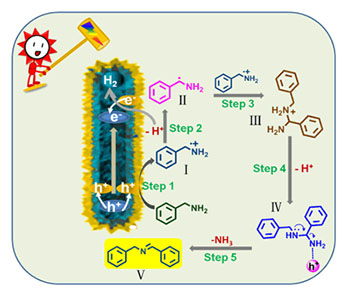| [1] Alvaro, M.; Carbonell, E.; Ferrer, B.; i Xamena, F. X. L.; Garcia, H. Chem. Eur. J. 2007, 13, 5106.
[2] Sun, D.; Li, Z. Chin. J. Chem. 2017, 35, 135.
[3] Chouhan, A.; Pilet, G.; Daniele, S.; Pandey, A. Chin. J. Chem. 2017, 35, 209.
[4] Zhang, W.; Li, Q.; Yang, X.; Ma, Z.; Wang, H.; Wang, X. Acta Chim. Sinica 2017, 75, 80. (张文强, 李秋艳, 杨馨雨, 马征, 王欢欢, 王晓军, 化学学报, 2017, 75, 80.)
[5] Shen, K.; Chen, X.; Chen, J.; Li, Y. ACS Catal. 2016, 6, 5887.
[6] Jiao, L.; Wang, Y.; Jiang, H. L.; Xu, Q. Adv. Mater. 2018, 30, 1703663.
[7] Fang, Y.; Zhu, S. R.; Wu, M. K.; Zhao, W. N.; Han, L. J. Solid State Chem. 2018, 266, 205.
[8] Feng, J.; Yang, Z.; He, S.; Niu, X.; Zhang, T.; Ding, A.; Liang, H.; Feng, X. Chemosphere 2018, 212, 114.
[9] Li, X.; Weng, B.; Zhang, N.; Xu, Y. J. RSC Adv. 2014, 4, 64484.
[10] Yan, B.; Zhang, L.; Tang, Z.; Al-Mamun, M.; Zhao, H.; Su, X. Appl. Catal. B:Environ. 2017, 218, 743.
[11] Xu, X.; Liu, R.; Cui, Y.; Liang, X.; Lei, C.; Meng, S.; Ma, Y.; Lei, Z.; Yang, Z. Appl. Catal. B:Environ. 2017, 210, 484.
[12] Liu, L.; Ding, L.; Liu, Y.; An, W.; Lin, S.; Liang, Y.; Cui, W. Appl. Catal. B:Environ. 2017, 201, 92.
[13] Peng, S.; Li, L.; Wu, Y.; Jia, L.; Tian, L. L.; Srinivasan, M.; Ramakrishna, S.; Yan, Q.; Mhaisalkar, S. G. CrystEngComm 2013, 15, 1922.
[14] Yu, B. J.; Su, Y.; Cheng, B. Adv. Funct. Mater. 2007, 17, 1984.
[15] Li, X.; Yu, J.; Jaroniec, M. Chem. Soc. Rev. 2016, 45, 2603.
[16] Shen, R.; Jiang, C.; Xiang, Q.; Xie, J.; Li, X. Appl. Surf. Sci. 2019, 471, 43.
[17] Mao, C.; Cheng, H.; Tian, H.; Li, H.; Xiao, W. J.; Xu, H.; Zhao, J.; Zhang, L. Appl. Catal. B:Environ. 2018, 228, 87.
[18] Meng, S.; Ye, X.; Ning, X.; Xie, M.; Fu, X.; Chen, S. Appl. Catal. B:Environ. 2016, 182, 356.
[19] Yang, Z.; Xu, X.; Liang, X.; Lei, C.; Gao, L.; Hao, R.; Lu, D.; Lei, Z. Appl. Surf. Sci. 2017, 420, 276.
[20] Lang, X.; Chen, X.; Zhao, J. Chem. Soc. Rev. 2014, 43, 473.
[21] Xu, Y.; Chen, Y.; Fu, W. F. Appl. Catal. B:Environ. 2018, 236, 176.
[22] Proctor, A. D.; Panuganti, S.; Bartlett, B. M. Chem. Commun. 2018, 54, 1101.
[23] Raza, F.; Park, J. H.; Lee, H. R.; Kim, H. I.; Jeon, S. J.; Kim, J. H. ACS Catal. 2016, 6, 2754.
[24] Sun, D.; Ye, L.; Li, Z. Appl. Catal. B:Environ. 2015, 164, 428.
[25] Liu, H.; Xu, C.; Li, D.; Jiang, H. Angew. Chem. 2018, 130, 5477.
[26] Wang, S.; Guan, B. Y.; Lu, Y.; Lou, X. J. Am. Chem. Soc. 2017, 139, 17305.
[27] Zhang, Y.; Zhou, J.; Chen, X.; Feng, Q.; Cai, W. J. Alloys Compd. 2019, 777, 109.
[28] Samanta, S.; Khilari, S.; Srivastava, R. ACS Appl. Nano Mater. 2018, 1, 426.
[29] Wang, M.; Li, L.; Lu, J.; Luo, N.; Zhang, X.; Wang, F. Green Chem. 2017, 19, 5172.
[30] Liang, R.; Shen, L.; Jing, F.; Wu, W.; Qin, N.; Lin, R.; Wu, L. Appl. Catal. B:Environ. 2015, 162, 245.
[31] Peng, Y.; Zhao, M.; Chen, B.; Zhang, Z.; Huang, Y.; Dai, F.; Lai, Z.; Cui, X.; Tan, C.; Zhang, H. Adv. Mater. 2018, 30, 1705454.
[32] Zhao, K.; Zhang, X.; Zhang, L. Electrochem. Commun. 2009, 11, 612. |
